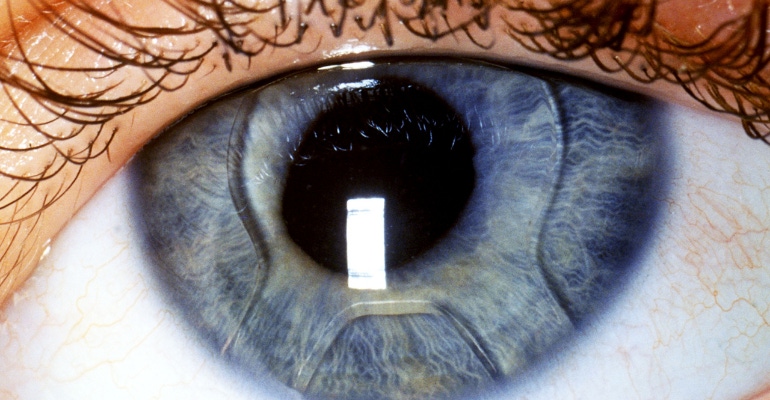Analyst sees attractive growth drivers in contact lens and intraocular lens markets.
April 11, 2022

Johnson & Johnson recently changed the game for contact lens wearers suffering from allergic eye itch by winning FDA approval for a drug-eluting contact lens. Now, medtech analysts at Needham & Co. have issued a report in which they take a closer look at both the contact lens market and the intraocular lens market, noting how both markets are poised for growth.
"We believe both markets are attractive given their respective exposure to growth drivers that are somewhat insulated from pure volume growth," wrote Needham analysts David Saxon, Mike Matson, and Joseph Conway. "We believe each market's growth could increase to above its historical mid-single digit rate as a result of a mix shift to premium products."
The report follows the firm's coverage initiation of Alcon, Cooper Companies, RxSight, and STAAR Surgical.
Analysts see a mix shift toward premium contact lenses
The Needham analysts report a mix shift toward premium lenses, which should serve as a durable growth driver for the roughly $9B contact lens market.
"There is an increasing shift from monthly and two-week replacement contact lenses to daily contact lenses, which can be [between four and six times] the price," the analysts wrote. "There is another shift from hydrogel to silicone hydrogel, which can add another 20-40% premium."
The analysts also note that improving the conversion rate from trialing to permanent wearer could be a meaningful tailwind to market growth, and that a higher retention rate at the older end of the wearer spectrum triggered by further improvements to multifocal contact lenses could increase stability in the wearer base for contact lenses.
Staar Surgical nabbed FDA approval in March for its highly anticipated EVO/EVO+ Visian Implantable Collamer Lens for the correction of myopia (nearsightedness, or the need for distance vision correction) and myopia with astigmatism. The Lake Forest, CA-based company estimates that 100 million U.S. adults between the ages of 21 and 45 who have myopia are potential candidates for EVO, a biocompatible implantable lens designed to correct distance vision.
The Needham & Co. analysts note that most refractive error correction procedures incorporate laser technology, such as Lasik, to reshape the cornea. However, the analysts said that, according to the eye doctors they spoke with, these procedures can usually only correct up to about -8 to -10 diopters. Staar's implantable collamer lens, on the other hand, can be implanted in people with more severe refractive errors, the analysts report.
Analysts expect premium lenses in cataract surgeries to drive growth in the intraocular lens (IOL) market
Intraocular lenses, which are implanted during cataract procedures to replace the patient's natural lens, are also advancing. The medtech analysts at Needham & Co. note in their report that the majority of intraocular lens volume is monofocal (about 85%) but toric and advanced technology intraocular lenses have improved in recent years. They said toric and advanced technology intraocular lenses can be anywhere from three to four times and six to eight times the price of monofocal IOLs, respectively.
"We expect a sustained mix shift to be a significant tailwind for the IOL market," they wrote.
Another potential indicator of growth for the intraocular lens market comes from Google Trends analytics. Needham's Matson has been tracking procedure volumes across a variety of surgical specialties weekly since the early days of the pandemic using Google Trends. The report notes that, according to Google Trends for the week ending April 2, 2022, cataract procedure volumes are trending better than orthopedic and cardiovascular procedures.
The analysts estimate the intraocular lens market is currently valued at about $3B.
In a separate report, the Needham & Co. analysts point out that RxSight has a differentiated intraocular lens system that consists of a light adjustable lens (LAL) and a light delivery device (LDD). According to the analysts, the LAL intraocular lens can be adjusted after the procedure to provide tailored visual correction. This compares to other IOLs, they say, where the patient and doctor decide before the operation on the intraocular lens based on the patient's visual preferences, which sometimes requires either prescription glasses or laser vision correction to treat residual refractive errors. The eye doctors that the medtech analysts consulted suggests that RxSight's LALs could be appropriate for up to 20% of patients.
As for Alcon, in March the company reported that its AcrySof IQ PanOptix Trifocal Intraocular Lens has surpassed more than one million implants worldwide. This multifocal IOL is used to focus images clearly onto the back of the eye (the retina) to allow clear vision after the cataract removal, Alcon said. In addition, the center of this intraocular lens allows for better near (reading) vision and intermediate (computer work) vision versus what a monofocal lens would provide, the Geneva, Switzerland-based company said.
Alcon also launched the Clareon family of IOLs in the United States in March. Using Alcon's most advanced intraocular lens material, Clareon is designed to deliver "consistent visual outcomes and exceptional clarity that lasts," according to the company. The new intraocular lens uses a glistening-free IOL material that, according to Alcon, has among the lowest levels of haze and subsurface nanoglistenings compared to leading competitor IOLs.
About the Author(s)
You May Also Like




